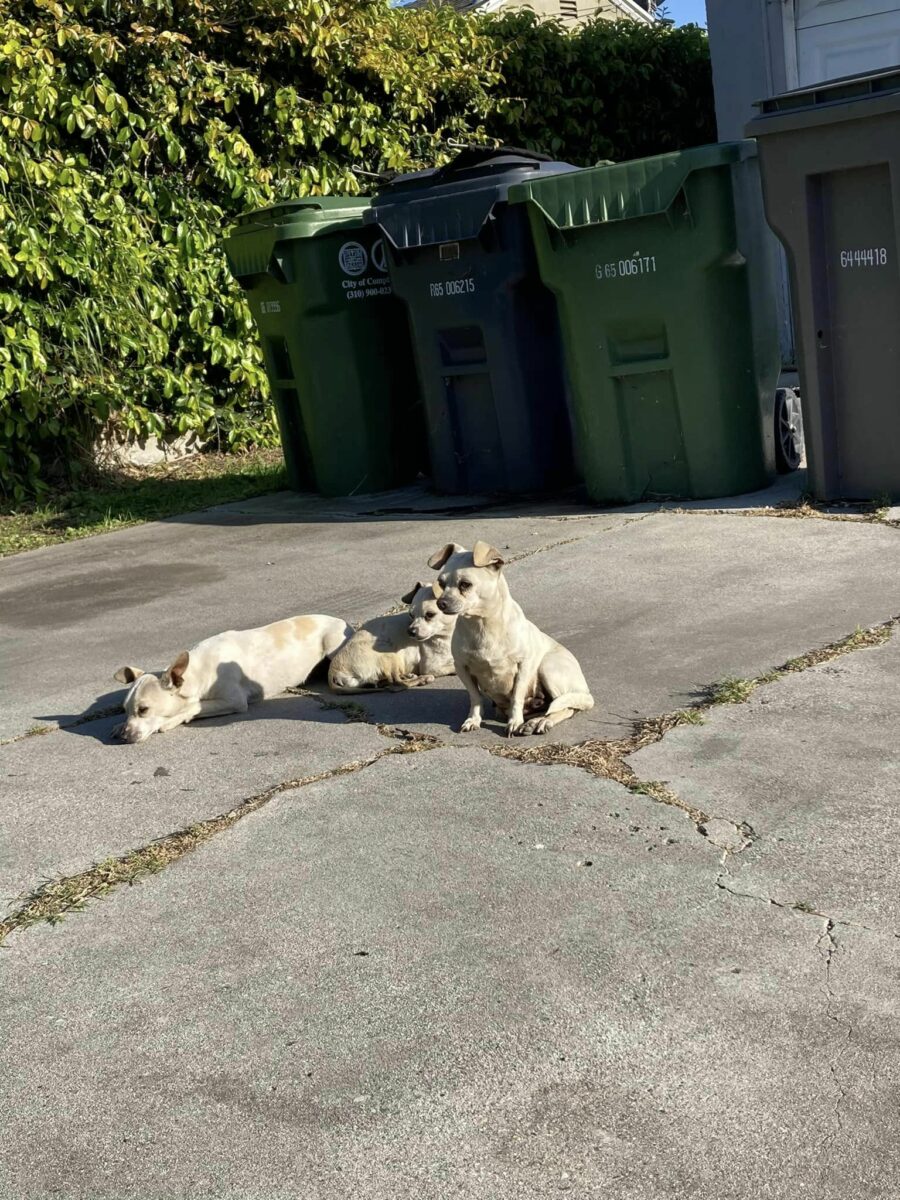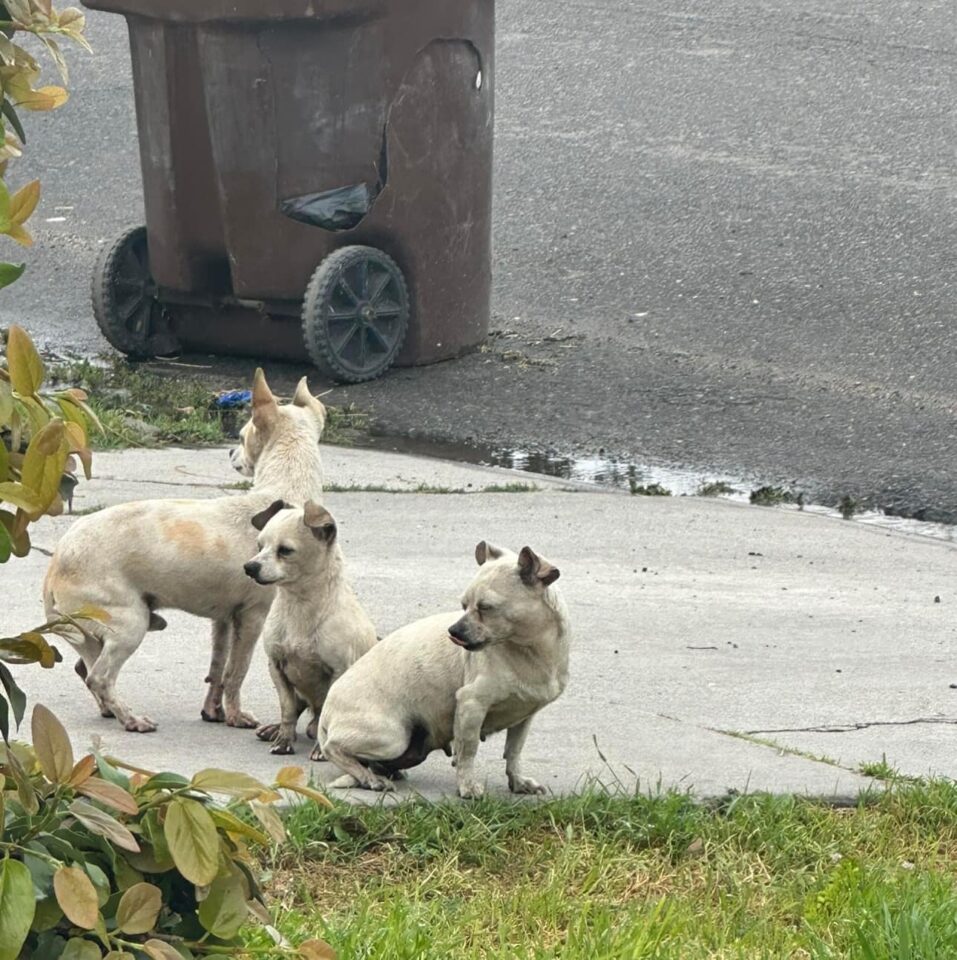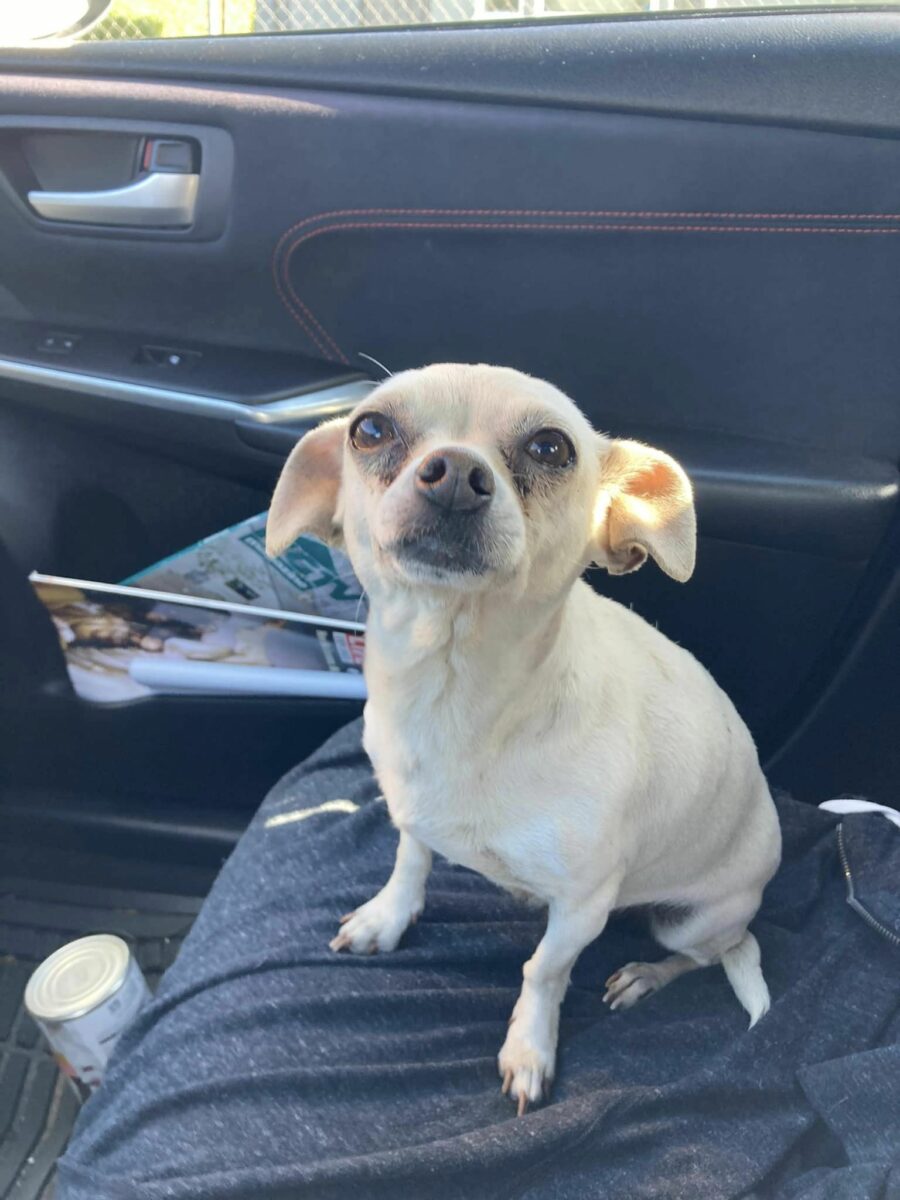Suzette Hall, the founder of a California-based rescue by the name of Logan’s Legacy 29, constantly receives calls about stray pups who wander the streets of Southern California looking for a kind hooman who will offer them a helping hand.
However, one day, she received a call that wasn’t like the rest.
A Good Samaritan contacted Hall to inform her that they came across not one but three sweet pups who were roaming around an abandoned property in Compton, refusing to leave each other’s side.
Help Is On The Way

As soon as Hall received this information, she immediately knew that this would be no easy task. Catching one scared pup is a very difficult thing, let alone three.
But, she knew she had to come up with a good plan as she was their only hope.
“It was beyond heartbreaking to see. They are all so tiny,” Hall wrote on Facebook.
Unfortunately, Hall’s rescue mission was unexpectedly delayed for a couple of days because her rescue van had some mechanical issues.
Luckily, her friend, Mary Nakiso, took it upon herself to visit the pups every single evening and bring them nutritious food to keep them healthy and energized while they waited for their rescuer.

When Hall finally managed to arrive, she was shocked to see just how loyal the pups were to each other.
“They were so scared, but they had each other. And boy, do they love each other,” Hall stated.
Hall decided to keep a distance because she didn’t want to frighten the pups by getting in their space too fast. Then, she spoke to them in a sweet and soothing tone, showering them with words of affirmation in order to show them that they were in safe hands and that there was nothing to worry about.
Hall managed to capture the smallest pup of the three rather quickly while Nakiso tried to gain the trust of the middle one. Luckily, it didn’t take her too long, and both of the pups were safe in no time.
“The little girl loved Mary so much, and Mary was able to get her,” Hall wrote.
The smallest pup, named Oscar, and his sister, named Jolene, were anxiously waiting in the safety of Hall’s van while the rescuers went back for their older brother, Ollie.
“The third baby boy was so beyond scared, he kept going into the garage,” she wrote.
Seeing that he just did not trust them, Hall and Nakiso decided that it would be for the best if they gave him some space to decompress while they took his siblings to the Camino Pet Hospital in California.
Second Try
Later that same evening, Hall came back to the abandoned property to try and capture Ollie again, but this time, she brought some backup.
The rescuer thought it would be easiest to set up a humane trap next to the garage in which Ollie was hiding and hoped that he would enter it on his own.

When she came back in the morning, she was overjoyed when she saw Ollie patiently sitting in the trap, waiting for her to come and get him.
She immediately drove the sweet boy to the vet hospital, where she reunited with his adorable siblings.
“They were all so scared. So cold, so hungry. But they were finally all safe. They had each other again,” Hall wrote.

These sweet triplets received a thorough checkup at the hospital before heading off to their foster home. Hall’s friend, Genavie Ochoa, offered to take in all three of them so that they wouldn’t be separated.
Ever noticed your furry friend twitching or whimpering in their sleep? As a seasoned dog trainer, you’re no stranger to the peculiar behaviors our canine companions exhibit. Dogs, with their keen senses and vivid dreams, often leave us wondering – do they have nightmares? The world of a dog’s mind is a fascinating realm, filled with mysteries that we, as their faithful guides, strive to understand.
In your journey alongside these loyal creatures, you’ve witnessed the range of emotions they experience, from joyous tail wags to fearful cowering. As you observe them snooze peacefully or restlessly, the question lingers: could they be chasing rabbits in their dreams or battling invisible foes? The enigmatic world of dog dreams invites us to ponder the depths of their subconscious and explore the possibility of nighttime adventures beyond our imagination.
Exploring Dog Dreams and Nightmares
Wondering if your furry friend has nightmares? Well, dogs do dream like humans do. They go through sleep cycles, including the REM (Rapid Eye Movement) phase where dreaming occurs. During this phase, you might notice their paws twitching or hear soft barks. This signals that they are in the midst of a dream.
Dog dreams typically involve activities from their daily lives. Dogs often dream about things like playing, running, or even chasing something. These dreams are usually not scary or distressing. They’re just a reflection of their daily experiences.
But what about nightmares? While dogs can have bad dreams, it’s not clear if they experience something as complex as human nightmares. Some researchers believe that negative experiences could influence a dog’s dreams, leading to occasional distress during sleep.
If your dog seems agitated or scared while sleeping, gently wake them up with soft words or a reassuring touch. Creating a calm environment before bedtime might help reduce the chances of disturbing dreams. Remember, being a comforting presence for your pup can make a big difference in ensuring they have restful nights.
Understanding Canine Sleep Patterns
When it comes to understanding your furry friend’s sleep patterns, knowing that dogs experience dreams during the REM phase is key. Dogs, like humans, display similar dream-indicative behaviors, such as paw twitching and soft barking, during this sleep stage.
- REM Phase in Dogs:
During the REM phase, your dog is likely dreaming vividly. You might notice them twitching their paws or making soft noises, indicating they’re in the midst of a dream. - Dream Content:
A dog’s dreams often reflect their daily activities, such as playing, running, or interacting with family members. These dreams are usually influenced by their waking experiences. - Negative Experiences:
Just like humans, dogs can have bad dreams influenced by negative experiences. It’s essential to provide a secure and comforting environment for your furry companion to help reduce the likelihood of unsettling dreams. - Nightmare Uncertainty:
While dogs may have bad dreams, the idea of complex nightmares, as experienced by humans, remains uncertain in the canine world.
To ensure your dog has restful nights, gently waking them up during distress and establishing a calming bedtime routine can be beneficial. Being a comforting presence for your furry friend can make a significant difference in their overall sleep quality and well-being.
Remember, understanding your dog’s sleep patterns can help you provide the support and care they need for a peaceful night’s rest.
Factors Influencing Canine Nightmares
Environmental Factors
Create a peaceful sleeping environment for your dog by providing a comfortable bed and ensuring the room is dark and quiet. Avoid sudden loud noises during their nap time to minimize disturbances that could lead to unsettling dreams.
Physical Well-being
Ensure your dog’s physical health is optimal by providing regular exercise and a balanced diet. A tired and hungry dog may experience more vivid dreams that could potentially turn into nightmares.
Emotional State
Monitor your dog’s emotional well-being and provide a loving and stress-free environment. Anxiety and fear during the day can manifest as nightmares during sleep. Consistent positive interactions and mental stimulation can help reduce the likelihood of negative dreams.
Past Traumatic Experiences
Dogs that have a history of abuse or traumatic experiences may be more prone to nightmares. Providing a secure and loving home can help alleviate the impact of past traumas on your dog’s dreams.
Age and Breed
Younger dogs and certain breeds may have more active dream cycles, increasing the chances of experiencing nightmares. Understanding your dog’s breed tendencies and adapting their sleep environment accordingly can help reduce the occurrence of distressing dreams.
Health Conditions
Some health conditions, such as pain or neurological issues, can influence the quality of your dog’s sleep and potentially lead to nightmares. Regular veterinary check-ups and appropriate management of any underlying health issues can contribute to better dream experiences for your furry companion.
Managing Canine Nightmares
When it comes to managing your dog’s nightmares, there are practical steps you can take to help them have a more peaceful sleep.
Creating a Safe Environment
Start by ensuring that your dog’s sleeping area is comfortable and secure. Provide a cozy bed in a quiet and calm location to minimize disruptions during their rest.
Establishing a Bedtime Routine
Implementing a consistent bedtime routine can signal to your dog that it’s time to wind down and relax. Engage in calming activities before bedtime, such as a short walk or gentle play, to help them transition to sleep.
Monitoring Noise Levels
Be mindful of noise levels in your home, especially during the evening. Loud sounds can startle your dog awake, potentially leading to unsettling dreams. Create a soothing environment by reducing noise where possible.
Promoting Emotional Well-being
Pay attention to your dog’s emotional state and provide them with reassurance and companionship. Positive interactions and affection can help alleviate anxiety and promote feelings of security, contributing to more peaceful sleep.
Addressing Past Traumas
If your dog has experienced past traumas or negative encounters, consider seeking professional guidance to help them work through these experiences. Addressing underlying issues can reduce the likelihood of distressing dreams.
Considering Breed Characteristics
Different dog breeds may have varying tendencies when it comes to dreaming. Understanding your dog’s breed characteristics can provide insight into their dream patterns and behaviors, allowing you to better support their sleep needs.
Managing Health Conditions
Regular veterinary check-ups are crucial in ensuring your dog’s overall health and well-being. Health conditions, such as pain or discomfort, can impact sleep quality and contribute to nightmares. Keep track of any changes in your dog’s behavior and consult your veterinarian if needed.
By creating a soothing sleep environment, supporting your dog’s emotional health, and addressing any underlying issues, you can help manage canine nightmares and promote restful sleep for your furry companion.
Conclusion
So, there you have it – dogs can indeed have dreams and even nightmares, just like us. While the exact nature of their nightmares remains a bit of a mystery, it’s clear that various factors can influence their dream experiences. By creating a cozy and safe sleeping environment, sticking to a calming bedtime routine, and addressing any past traumas or health issues, you can help your furry friend have sweeter dreams. Remember, paying attention to your dog’s emotional well-being and unique characteristics can make a big difference in ensuring they have peaceful and restful sleep. So, next time you see your pup twitching or softly barking in their sleep, know that they might just be chasing squirrels in dreamland.
Frequently Asked Questions
Do dogs have dreams like humans?
Yes, dogs do have dreams similar to humans, especially during the REM phase of sleep. They may exhibit dream-like behaviors such as paw twitching and soft barking.
Can dogs have nightmares?
Yes, dogs can have nightmares, often triggered by negative encounters they have experienced. Factors like past traumas, age, breed tendencies, and health conditions can influence the occurrence of nightmares in dogs.
How can I help my dog with nightmares?
To help your dog with nightmares, create a safe sleep environment, establish a calming bedtime routine, monitor noise levels, promote emotional well-being, address past traumas, consider breed characteristics, and manage any health conditions.
[no_toc]

Hey there, I’m Janet Brooks, a dog-loving student from California. I’m all about helping pups in need, especially those without homes. Me and my awesome friends work together to give shelter and love to stray dogs. Oh, and I also write blogs about dogs to share helpful info.